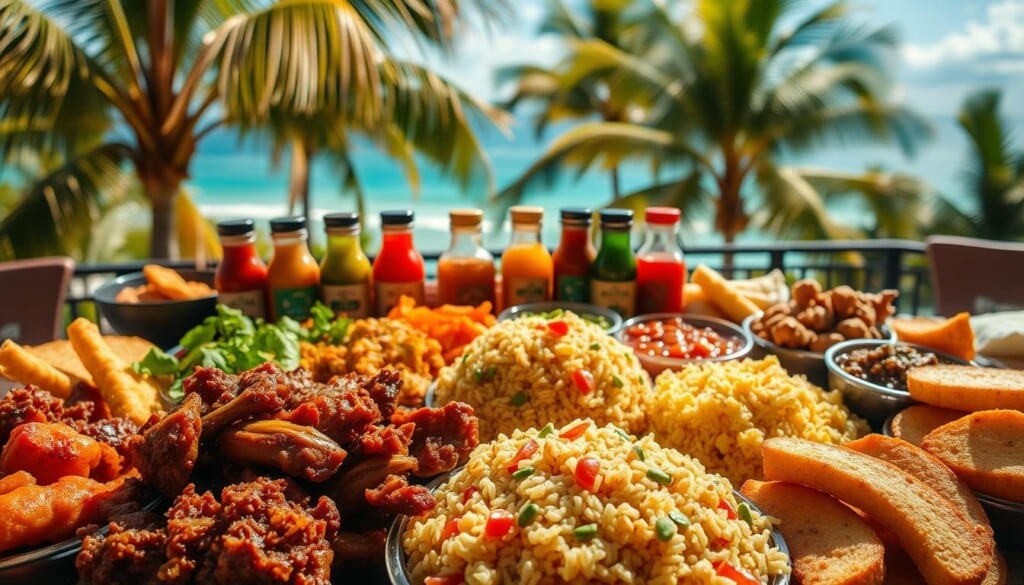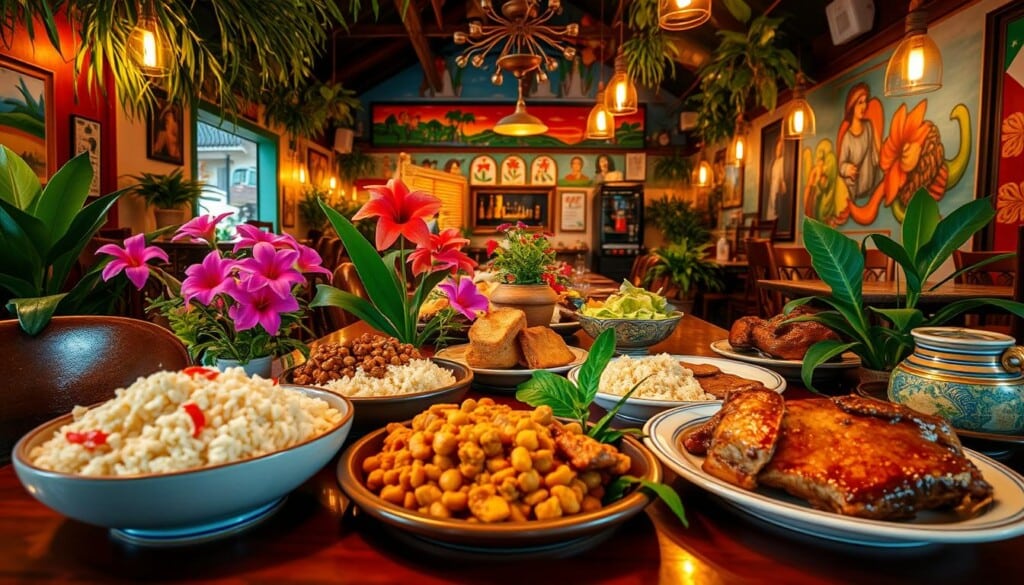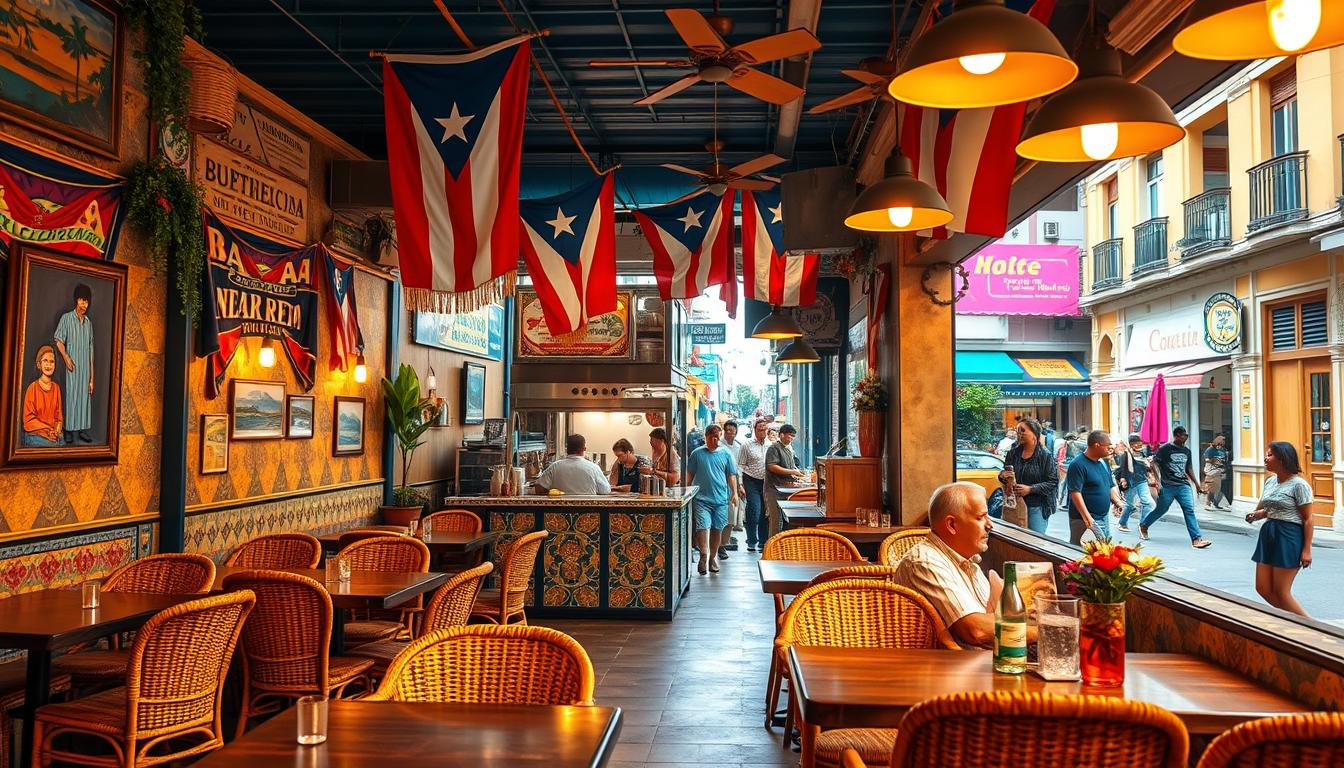Have you ever wondered how a small island’s vibrant culinary traditions have made their way into the heart of American gastronomy? Puerto Rican food restaurants across the United States showcase the rich and diverse flavors of authentic Puerto Rican cuisine. They entice food lovers to explore delicious options. As you embark on this culinary journey, you will discover not just a meal but a heritage reflected in every dish.
From savory mofongo to tantalizing lechón asado, the best Puerto Rican food near me can be an exciting search. It reveals hidden gems dedicated to sharing this island’s unique culinary story. Join us as we dive into the world of Puerto Rican cuisine and the renowned restaurants that specialize in authentic dishes that pay homage to their roots.
Key Takeaways
- Penned by a rich island tradition, Puerto Rican food holds cultural significance in America.
- Puerto Rican food restaurants offer a diverse menu, appealing to various tastes.
- Exploring authentic Puerto Rican cuisine can introduce new and exciting flavors.
- Location plays a key role in finding the best Puerto Rican food near you.
- Each dish tells a story, contributing to the appreciation of Puerto Rican heritage.
Introduction to Puerto Rican Cuisine
Puerto Rican cuisine is a mix of cultures from the Caribbean. It combines Taino, African, and Spanish traditions. This blend creates dishes with bold and vibrant flavors.
The Flavors of the Caribbean
Caribbean flavors are key in Puerto Rican dishes. Spices like adobo and sofrito are essential. They add warmth and depth to the food.
Using fresh ingredients is a big part of Puerto Rican cooking. It brings the islands’ essence to every dish.
Essential Ingredients in Puerto Rican Dishes
Rice, beans, plantains, and meats are staples in Puerto Rican cooking. They make dishes hearty and satisfying.
Each dish balances flavors and textures. This shows the richness of Puerto Rican cuisine. From stews to fried foods, meals share stories of heritage and community.
Why Puerto Rican Food is a Must-Try
The Puerto Rican dining experience is full of flavor and tradition. It’s a journey into the island’s vibrant heritage. Meals are made with unique techniques like slow-roasting and frying.
This creates layers of flavor that make every bite special.
Unique Culinary Techniques
In Puerto Rican cuisine, cooking techniques are key. Slow-roasting is used for dishes like lechón asado. Whole pigs are seasoned and cooked until tender and flavorful.
Frying is also common, like in mofongo. Green plantains are fried and mashed, creating a tasty texture. These methods show off the cook’s skill and the island’s rich agriculture.
Cultural Significance of Puerto Rican Meals
Meals in Puerto Rico are more than just food. They bring families together during celebrations. Traditional recipes carry stories and memories, enriching Puerto Rican culture.
Each meal connects us to our past. It shows the importance of food in building social bonds and pride, both on the island and abroad.
Popular Dishes You Should Try
Puerto Rican cuisine is filled with iconic dishes that show the island’s rich food heritage. Mofongo is a standout among these dishes. It’s made from fried plantains mashed with garlic, pork cracklings, and spices. It’s both a side and a main dish, highlighting Puerto Rican cooking’s creativity and flavors.
Mofongo: A Classic Staple
Mofongo is known for its unique texture and savory taste. It’s often served with broth and paired with meats or seafood. The way chefs mix plantains and seasonings is an art, making sure each bite is full of Puerto Rican flavors.
Lechón Asado: The Roast Pork Delight
Lechón asado is a true culinary tradition. It’s a whole roast pig marinated in special spices and slow-cooked until tender. It’s a favorite at celebrations, not just for its taste but also for its role in Puerto Rican culture.
Arroz con Gandules: Rice with Pigeon Peas
Arroz con gandules is a comforting and vibrant dish. It’s made with rice, pigeon peas, and spices. It’s a key part of holiday meals and family gatherings, bringing together the heart and soul of Puerto Rican food.

The Rise of Puerto Rican Food Restaurants
More Puerto Rican food restaurants are popping up in the US. This shows a growing love for different food traditions. These spots are becoming key parts of American food culture, thanks to their unique dishes and local twists.
A Growing Trend in the US
Urban areas with big Puerto Rican communities are seeing more of these restaurants. They’re not just places to eat. They’re cultural centers that connect people to their heritage through food. Here, chefs use fresh ingredients and old recipes to bring the island’s flavors to life.
Celebrating Puerto Rican Heritage Through Food
Food is a big part of celebrating heritage. Puerto Rican restaurants share stories and traditions through their dishes. They highlight the importance of family and community, making every meal a celebration of Puerto Rican culture.
Finding Puerto Rican Restaurants Near You
LocalZ makes finding great Puerto Rican food easy. It’s a digital directory that lets you search for specific cuisines. You can also read reviews and filter by your preferences. This way, you can find authentic Puerto Rican dishes that showcase the islands’ rich flavors and traditions.
Using LocalZ to Discover Dining Gems
LocalZ is a great tool for finding Puerto Rican restaurants near you. Its easy-to-use interface lets you enter your location and see a list of dining options. Each listing has important details like contact info, directions, and reviews. This ensures you have all the info you need.
How to Search for Authentic Puerto Rican Cuisine
To find authentic Puerto Rican cuisine, use specific search terms on LocalZ. Look for restaurants that are family-owned or serve traditional recipes. This helps you find places that truly represent Puerto Rican culture. It’s a good way to support local businesses that offer a genuine dining experience.
Dining Experience: What to Expect
The Puerto Rican dining experience is more than just food. It’s a dive into a rich culture that values flavors, traditions, and community. Restaurants in Puerto Rico create a welcoming space that captures the island’s spirit. They invite visitors to embark on a culinary adventure.
Atmosphere and Ambiance
Restaurants in Puerto Rico are known for their vibrant colors and traditional decorations. The lively music adds to the island’s spirit. Guests feel the energy, making their visit unforgettable.
Friendly Service and Community Engagement
Service in Puerto Rican restaurants is always friendly. Waitstaff often chat with guests, creating a real connection. This focus on community makes every meal a chance for laughter and shared stories.

Notable Puerto Rican Food Restaurants
Top Puerto Rican restaurants across the United States bring the vibrant flavors of the island to life. Places like Casa Blanca in New York City, La Placita in San Francisco, and El Coquí in Chicago are known for their tradition and quality. They draw in both locals and visitors who want to try real Puerto Rican food.
Casa Blanca in New York City
Casa Blanca is a standout spot, famous for its traditional dishes and fun vibe. It offers a wide range of dishes, including mofongo and arroz con gandules, all made with care. Its focus on authenticity makes it a key spot for Puerto Rican food lovers.
La Placita in San Francisco
La Placita is a special place that celebrates Puerto Rican culture with its tasty menu. The cozy atmosphere and classic dishes attract food lovers looking for a true Puerto Rican taste. The use of fresh ingredients makes every meal a treat.
El Coquí in Chicago
El Coquí is known for its deep dive into Puerto Rican cooking. Located in Chicago’s heart, it serves beloved dishes that showcase the island’s heritage. Known for its friendly service and quality, El Coquí embodies the lively culinary tradition of Puerto Rico.
Reviews and Recommendations
What diners say is key to great dining experiences at Puerto Rican restaurants. Looking at reviews, we see what customers love most. They rave about dishes like mofongo and lechón asado, showing why they keep coming back.
Reviews point out the top dishes that win hearts. These authentic experiences leave a mark, helping newcomers enjoy Puerto Rico’s rich food culture. Feedback helps restaurants stay top-notch and keep improving, making the dining scene lively and true to its roots.
Takeout and Delivery Options Available
Many Puerto Rican restaurants now offer takeout and food delivery. This change lets customers enjoy their favorite dishes at home. You can get everything from mofongo to lechón asado delivered to your door.

Top delivery services make it easy to get these dishes delivered. When you look for Puerto Rican takeout, use platforms that focus on restaurant deliveries. This way, you can enjoy authentic flavors without leaving your house.
Connecting with Local Businesses
Building strong ties with local businesses is key for a community’s culture and economy. LocalZ helps by making it easy to find and support Puerto Rican restaurants. This way, people help keep diverse foods alive and make their neighborhoods better.
The Role of LocalZ in Supporting Restaurants
LocalZ is a big help for both customers and restaurants. It lets users find Puerto Rican places to eat nearby. This supports local businesses, which are the heart of community culture. It also helps restaurants get more customers and build stronger relationships with them.
Building Community Through Food
Food is a great way to bring people together. By supporting local eateries, like those on LocalZ, we help keep cultural traditions alive. It also helps the local economy grow. Eating at local restaurants does more than just feed us; it strengthens our community bonds and makes us feel more connected.
The Importance of Local Engagement
Local engagement is key to growing and connecting communities. LocalZ shows this by giving 50% of its annual Business Listing Fee to local groups. This helps both the restaurants listed and boosts cultural and gender diversity in the local food scene.
Giving Back to Communities Through LocalZ
LocalZ’s mission is all about giving back. The money from business listings goes to community projects. This helps local culture grow and diverse food experiences thrive.
By supporting local organizations, LocalZ strengthens the bond between businesses and residents. It creates a place where everyone wins.
Partnering with Local Organizations
Working with local groups is vital for progress. LocalZ teams up with non-profits and community groups. This way, the funds have a bigger impact.
These partnerships help community programs get the support they need. This boosts the local economy and social fabric.
Conclusion: Explore Puerto Rican Gastronomy
As we conclude our exploration of Puerto Rican food, we invite you to dive into the world of Puerto Rican cuisine. The variety of flavors and traditions in local restaurants is vast. Each dish has its own story, showing the cultural influences that make Puerto Rico’s food scene so vibrant.
Supporting local restaurants is more than just enjoying a meal. It helps these communities thrive. By doing so, you become part of a tradition that keeps Puerto Rican cuisine alive. This relationship between you and the restaurant helps new flavors and techniques emerge.
When you enter a local restaurant, you’re in for a treat. You might discover new flavors that will amaze you. Start your culinary adventure today and explore the rich flavors of Puerto Rico. For more local dining spots, check out this directory.

